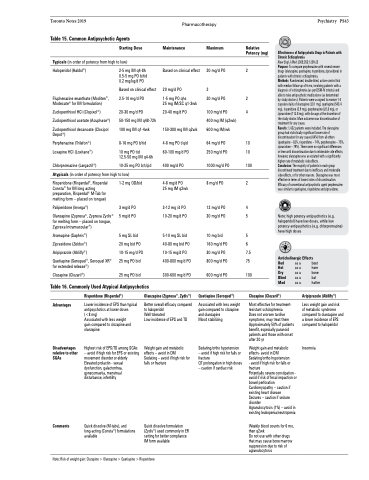Page 1207 - TNFlipTest
P. 1207
Toronto Notes 2019
Pharmacotherapy
Psychiatry PS43
Table 15. Common Antipsychotic Agents
Starting Dose
Typicals (in order of potency from high to low)
Maintenance
Based on clinical effect
20 mg/d PO
1-5 mg PO qhs
25 mg IM/SC q1-3wk
20-40 mg/d PO
150-300 mg IM q2wk
4-8 mg PO t/qid 60-100 mg/d PO
400 mg/d PO
4-8 mg/d PO 25 mg IM q2wk
3-12 mg /d PO 10-20 mg/d PO
5-10 mg SL bid 40-80 mg bid PO 10-15 mg/d PO 400-800 mg/d PO
300-600 mg/d PO
Maximum Relative Potency (mg)
20 mg/d PO 2
Effectiveness of Antipsychotic Drugs in Patients with Chronic Schizophrenia
New Engl J Med 2005;353:1209-23
Purpose: To compare perphenazine with several newer drugs (olanzapine, quetiapine, risperidone, ziprasidone) in patients with chronic schizophrenia.
Methods: Randomized, double-blind, active-control trial
Haloperidol (Haldol®)
Fluphenazine enanthate (Moditen®, Modecate® for IM formulation)
Zuclopenthixol HCl (Clopixol®) Zuclopenthixol acetate (Acuphase®)
Zuclopenthixol decanoate (Cloxipol Depot®)
Perphenazine (Trilafon®) Loxapine HCl (Loxitane®)
Chlorpromazine (Largactil®)
2-5 mg IM q4-8h 0.5-5 mg PO b/tid 0.2 mg/kg/d PO
Based on clinical effect 2.5-10 mg/d PO
20-30 mg/d PO
50-150 mg IM q48-72h 100 mg IM q1-4wk
8-16 mg PO b/tid
10 mg PO tid 12.5-50 mg IM q4-6h
10-25 mg PO b/t/qid
with median follow-up of 6 mo, involving patients with a 2 diagnosis of schizophrenia (as per DSM-IV criteria) and
Atypicals (in order of potency from high to low)
20 mg/d PO 2
100 mg/d PO 4 400 mg IM (q2wk)
600 mg IM/wk
64 mg/d PO 10 250 mg/d PO 10
1000 mg/d PO 100
8 mg/d PO 2
12 mg/d PO 4 30 mg/d PO 5
10 mg bid 5 160 mg/d PO 6 30 mg/d PO 7.5 800 mg/d PO 75
600 mg/d PO 100
able to take antipsychotic medications (as determined
by study doctors). Patients were assigned to receive 1-4 capsules daily of olanzapine (20.1 mg), quetiapine (543.4 mg), risperidone (3.9 mg), perphenazine (20.8 mg), or ziprasidone (112.8 mg), with dosage at the discretion of the study doctor. Main outcome was discontinuation of treatment for any cause.
Results: 1,432 patients were included. The olanzapine group had statistically significant lower rate of discontinuation for any cause (64%) from all others (quetiapine – 82%, risperidone – 74%, perphenazine – 75%, ziprasidone – 79%). There were no significant differences in time until discontinuation due to intolerable side effects; however, olanzapine was associated with a significantly higher rate of metabolic side effects.
Conclusion: The majority of patients in each group discontinued treatment due to inefficacy and intolerable side-effects, or for other reasons. Olanzapine was most effective in terms of lowest rates of discontinuation. Efficacy of conventional antipsychotic agent perphenazine was similar to quetiapine, risperidone and ziprasidone.
Note: high potency antipsychotics (e.g. haloperidol) have low doses, while low potency antipsychotics (e.g. chlorpromazine) have high doses
Anticholinergic Effects
Risperidone (Risperdal®, Risperdal Consta® for IM long acting preparation, Risperdal® M-Tab for melting form – placed on tongue)
Paliperidone (Invega®)
Olanzapine (Zyprexa®, Zyprexa Zydis® for melting form – placed on tongue, Zyprexa Intramuscular®)
Asenapine (Saphris®)
Ziprasidone (Zeldox®)
Aripiprazole (Ablilfy®)
Quetiapine (Seroquel®, Seroquel XR® for extended release®)
Clozapine (Clozaril®)
1-2 mg OD/bid
3 mg/d PO 5 mg/d PO
5 mg SL bid 20 mg bid PO 10-15 mg/d PO 25 mg PO bid
25 mg PO bid
Red asa Hot asa Dry asa Blind asa Mad asa
beet hare bone bat hatter
Aripiprazole (Abilify®)
Less weight gain and risk of metabolic syndrome compared to olanzapine and a lower incidence of EPS compared to haloperidol
Insomnia
Table 16. Commonly Used Atypical Antipsychotics
Advantages
Disadvantages relative to other SGAs
Comments
Risperidone (Risperdal®)
Lower incidence of EPS than typical antipsychotics at lower doses
(<8 mg)
Associated with less weight
gain compared to clozapine and olanzapine
Highest risk of EPS/TD among SGAs – avoid if high risk for EPS or existing movement disorder or elderly Elevated prolactin - sexual dysfunction, galactorrhea, gynecomastia, menstrual disturbance, infertility
Quick dissolve (M-tabs), and long-acting (Consta®) formulations available
Olanzapine (Zyprexa®, Zydis®)
Better overall efficacy compared to haloperidol
Well tolerated
Low incidence of EPS and TD
Weight gain and metabolic effects – avoid in DM Sedating – avoid if high risk for falls or fracture
Quick dissolve formulation (Zydis®) used commonly in ER setting for better compliance IM form available
Quetiapine (Seroquel®)
Associated with less weight gain compared to clozapine and olanzapine
Mood stabilizing
Sedating/ortho hypotension – avoid if high risk for falls or fracture
QT prolongation in high doses – caution if cardiac risk
Clozapine (Clozaril®)
Most effective for treatment- resistant schizophrenia
Does not worsen tardive symptoms; may treat them Approximately 50% of patients benefit, especially paranoid patients and those with onset after 20 yr
Weight gain and metabolic effects- avoid in DM Sedating/ortho hypotension - avoid if high risk for falls or fracture
Potentially severe constipation - avoid if risk of fecal impaction or bowel perforation Cardiomyopathy – caution if existing heart disease
Seizures – caution if seizure disorder
Agranulocytosis (1%) – avoid in existing leukopenia/neutropenia
Weekly blood counts for 6 mo, then q2wk
Do not use with other drugs that may cause bone marrow suppression due to risk of agranulocytosis
Note: Risk of weight gain: Clozapine > Olanzapine > Quetiapine > Risperidone


